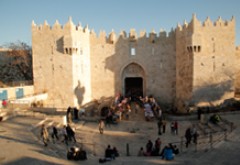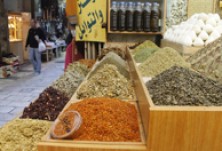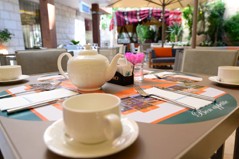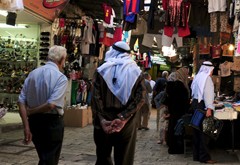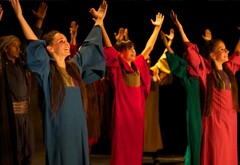Location and Name
Bab Al-Sahira is a small, modest gate, but it is richly decorative. It is located in the northern part of the Jerusalem Wall to the east of Bab al-‘Amud, leading to Harat (neighborhood) al-Sa’diyya and Harat Bab Hitta. The word al-Sahira in Arabic means the expansive level area, but its pronunciation changed to al-Zahira due to colloquial distortion. As a result, the gate also came to be known as Bab al-Zuhur (Flowers Gate) in Hebrew, although there is nothing in the gate’s architectural design to suggest the presence of any floral formations deserving of such a name. The gate was also known as Herod’s Gate, referring to Herod Antipas, who had a home in the area, accessible through a gate in this location. It was also known as Madeleine’s Gate during the Crusaders era. Bab al-Sahira is relatively small, compared to Bab al-‘Amud or Bab al-Asbat, but its construction was confirmed to be in the era of the Ottoman Sultan Suleiman I (Suleiman al-Qanuni) in 1537-1538 AD (944 H).
Plan
The current entrance of Bab al-Sahira is modern, dating back to the early 20th century. The original entrance was from the eastern side, in keeping with the construction style of walls in the middle ages, namely, the importance of having a low passageway or a right angle. This does not exist nowadays; the entry to the gate is in a straight line. The gate has a small entrance topped by a pointed arch. Between the entrance and the arch is a plate that is merely decorative and devoid of the usual inscription. The entrance leads to a van vaulte parlor, leading, in turn, to a passageway that shifts to the left and opens up into the city.
Geometric Motifs and their True Indications
The geometric decorations on the internal façade of the gate are worth noting. Three stone circles encompass geometric motifs. Some of them are hexagonal shapes that comprise two isosceles triangles, commonly known as Suleiman’s Ring or the Star of David. This particular shape is an original motif of Islamic art. It has nothing to do with rumors that it is an emblem of Israel today or a motto or rank of Suleiman al-Qanuni. Had this been the case, this motif would have been placed on Bab al-‘Amud or other gates, and not on a modest interior façade. It is therefore a purely Islamic, decorative motif.
Moving east, the visitor will see a decline in the ground, indicating the location of the moat that used to surround the northern Wall. After a few more steps, stopping at the tower opposite al-Rashidiyya School, this decline becomes clear, and one can see how much the ground surrounding the tower has risen since the Wall’s construction. The tower, with its beautiful decorations, and the inscription plate stand at eye level, while in other places at the Wall, such decorations are noticeably at a higher level.
Moving on a few meters eastwards, the visitor reaches the northeast part of the Wall and the Old City, where Burj al-Laqlaq stands.

